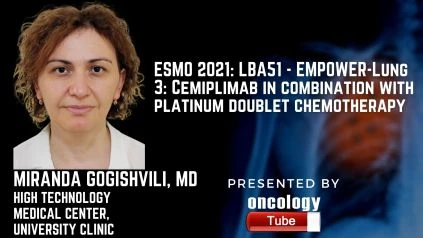Miranda Gogishvili, MD High Technology Medical Center, University Clinic speaks about ESMO 2021 Abstract – LBA51 – EMPOWER-Lung 3: Cemiplimab in combination with platinum doublet chemotherapy for first-line (1L) treatment of advanced non-small cell lung cancer (NSCLC).
Abstract LBA51
Background:
EMPOWER-Lung 3 is a two-part, randomized Phase 3 trial of 1L therapy in patients with advanced (Stage III/IV) squamous (SQ) or non-squamous (NSQ) NSCLC who do not have actionable mutations (NCT03409614). The study’s double-blind Part 2 enrolled patients regardless of their PD-L1 levels and compared the clinical activity and safety of cemiplimab, an anti-PD-1, plus (+) platinum-based chemotherapy to (vs) placebo (PBO)+chemo.
Methods:
Pts were randomly randomized (2:1; stratified by histology and PD-L1 expression) to receive cemiplimab 350 mg Q3W or PBO Q3W for 108 weeks (or until progression), plus up to four chemo cycles (followed by mandatory pemetrexed maintenance for NSQ pts assigned to a pemetrexed-containing regimen). Overall survival was the primary outcome (OS). Per blinded independent central review, key secondary objectives include progression-free survival (PFS) and objective response rate (ORR). Part 2 of the pre-specified 2nd interim analysis is shown here. The deadline for submitting data was June 14, 2021.
Results:
Overall, 466 patients were screened and assigned to one of two groups: cemiplimab+chemo (n=312) or PBO+chemo (n=154). The median (range) age of the participants was 63.0 (25-84) years, with 57.1 percent having NSQ NSCLC and 85.2 percent having Stage IV illness. With cemiplimab+chemo, the median OS was 21.9 months compared to 13.0 months with PBO+chemo (HR, 0.71; P=0.014). Compared to PBO+chemo, cemiplimab+chemo had a better median PFS (8.2 vs 5.0 months; HR, 0.56), a greater ORR (43.3 vs 22.7 percent), and a longer median duration of response (DOR) (15.6 vs 7.3 months) (Table). Grade 3 adverse events occurred 43.6 percent of the time in the cemiplimab+chemo arm and 31.4 percent of the time in the PBO+chemo arm.
Conclusions:
In patients with advanced NSCLC, 1L cemiplimab with chemo improved OS, PFS, ORR, and DOR compared to chemo alone, with a safety profile similar to cemiplimab monotherapy and platinum-based chemo.
Clinical trial identification
NCT03409614.

